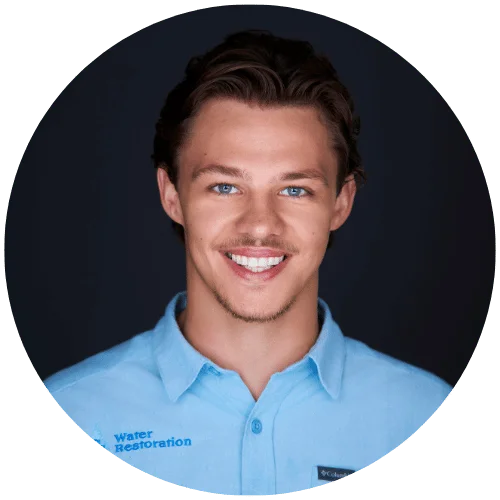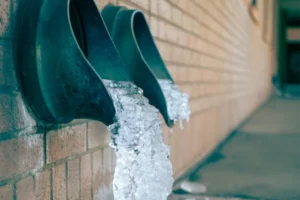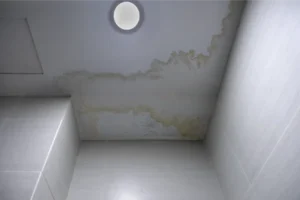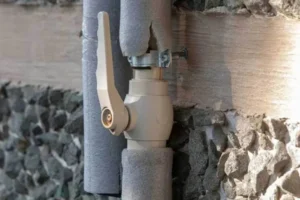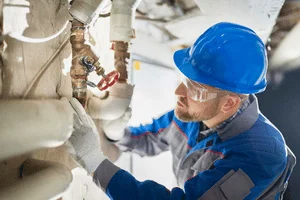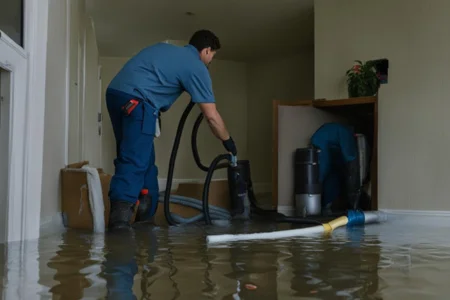Seasonal water damage can happen when you least expect it, and ignoring it can lead to unexpected repairs. From freezing pipes in winter to heavy rains and summer storms, each season brings unique challenges that increase the risk of leaks, flooding, and structural damage.
Homeowners can mitigate water damage by maintaining gutters, sealing foundations, and inspecting plumbing regularly. These steps help reduce seasonal water damage risks, preventing costly water damage in the home and protecting against water damage from seasonal effects like heavy rain, melting snow, or rapid temperature changes throughout the year.
With timely inspections, preventive maintenance, and awareness of early warning signs, you can minimize damage and reduce the need for extensive water damage repair. Let’s explore how to safeguard your property against seasonal water damage year-round.
Understanding Seasonal Water Damage Risks
Seasonal water damage is more than just a nuisance—it can compromise your home’s structure, ruin possessions, and even create health hazards. By recognizing seasonal risks, you can take preventive measures before minor issues escalate.
How Winter Weather Can Affect Your Home
Freezing temperatures, snow, and ice make winter a high-risk season for water damage. Ice can accumulate in gutters, blocking drainage and potentially causing roof leaks. Frozen pipes may burst, flooding walls, floors, and ceilings. Even minor, unnoticed leaks can quickly escalate, making emergency water damage restoration essential to minimize structural harm and mold growth.
Spring Thaws and Flooding Concerns
As snow melts and temperatures rise, spring thaws can lead to localized flooding. Heavy rainfall can overwhelm drainage systems, and water may accumulate near foundations or enter basements. Early recognition of pooling, wet spots, or minor leaks is crucial to prevent larger-scale damage that could require professional water removal services.
Summer Storms and Heavy Rainfall
Intense summer storms can quickly expose weaknesses in roofs, windows, and doors. Even small leaks can damage interiors and encourage mold growth if not addressed. Recognizing early water intrusion and responding promptly is key to limiting structural damage and reducing the scope of water damage repair.
Fall Rain and Gutter Overflow Issues
Autumn’s heavy rains, combined with fallen leaves, increase the likelihood of clogged gutters and downspout overflows. Overflowing water can seep into walls, basements, and foundations, causing significant damage over time. Understanding these seasonal risks allows homeowners like you to act quickly if signs of water intrusion appear, reducing the need for extensive repairs.
Common Signs of Seasonal Water Damage
You might notice several telltale signs of seasonal water damage in your home. Identifying these issues early can help you address them before they lead to more serious problems.
Water Stains on Ceilings and Walls
As the seasons change, water stains on ceilings and walls can become a telling sign of hidden issues within your home. Pay attention to:
- Texture changes: Bubbling wallpaper or peeling paint on the walls..
- Location: Near plumbing fixtures, windows, or exterior walls.
- Size: Expanding stains suggest worsening issues and persistent moisture..
- Smells: Bad and musty smells that linger and don’t go away.
- Mold/Mildew: Common in wet areas, these are signs of water intrusion.
If you spot any of these signs, don’t hesitate to contact water removal services to address the problem before it escalates.
Musty Odors and Mold Growth
A musty smell indicates moisture accumulation and potential mold. Mold spores can affect health, so address issues immediately. Consider mold remediation services if visible mold is present. Inspect damp areas like basements, bathrooms, and under sinks. Don’t ignore these signs; taking action will protect your family and maintain a healthy environment.
Flooring Damage and Warping
If you notice any of these signs, it’s advisable to act quickly:
- Buckling or cupping of boards.
- Cracks or gaps between planks.
- Discoloration or dark stains.
These issues not only affect the aesthetics of your home but can also lead to high-priced renovations. To avoid additional damage and ensure a safe living space, pay special attention to your flooring, particularly during wet seasons.
Basement Flood Indicators
If you’re noticing a sudden increase in humidity or musty odors in your basement, these could be clear indicators of potential flooding. Look for:
- Water stains or damp walls.
- Pooling water near foundations.
- Condensation on windows or pipes.
- Malfunctioning sump pumps.
Basements are especially prone to seasonal flooding, so stay vigilant to keep them dry and safe.
Preventive Measures for Each Season
To mitigate water damage, homeowners should prepare early for seasonal changes. Regular maintenance helps reduce seasonal water damage risks, preventing costly water damage in the home. Protect your property from water damage from seasonal effects like freezing pipes, heavy rainfall, and spring thaw that can compromise your home’s structure and safety.
Each season brings unique challenges that can lead to damage if you’re not prepared. Let’s explore what you can do to protect yourself from water-related problems in each season.
Winter: Protect Pipes and Water Lines
Frozen pipes can lead to severe damage, so don’t wait until it’s too late. Here are some practical measures you can take:
- Insulate exposed pipes.
- Let faucets drip during extreme cold.
- Open cabinet doors under sinks.
- Keep home heating consistent.
Spring: Clear Gutters and Inspect Roof
Spring is the perfect time to clear gutters and inspect your roof to prevent water damage repairs:
- Remove debris from gutters.
- Inspect the roof for missing or damaged shingles.
- Repair cracks in the foundation or walls.
Summer: Seal Windows and Check Drainage
Here are three key actions to keep in mind to help you enjoy a worry-free summer:
- Inspect and reseal windows.
- Ensure gutters and drains are clear.
- Test drainage systems after heavy rains.
Fall: Clean Gutters and Inspect Foundation
While the vibrant colors of fall bring beauty, they also signal the need for important home maintenance tasks:
- Remove leaves from gutters.
- Inspect the foundation and seal cracks.
- Direct water away from your home.
Worried About Seasonal Flooding? Our Specialists Can Help You Prevent Water Damage Before It Happens!
What to Do When You Spot Seasonal Water Damage
When you spot seasonal water damage, acting quickly can prevent it from escalating into a major repair.
Immediate Steps to Limit Damage
Do this as soon as you notice signs of seasonal water damage:
- Stop the water source.
- Move belongings away from affected areas.
- Use fans or dehumidifiers to dry the space.
- Search and monitor for mold growth.
When to Call a Professional Water Damage Restoration Company
Spotting seasonal water damage can be alarming, especially if you’re unsure how to handle it. If you notice significant pooling water, mold growth, or structural damage, call in a restoration expert. Professionals have the tools and experience to assess the situation and mitigate further damage. The longer you delay, the worse the damage may become.
Documenting Damage for Insurance Claims
If you notice signs of seasonal water damage, document everything immediately for your insurance claim. Follow these steps:
- Take clear photos.
- List damaged items with value.
- Record when the damage occurred.
- Notify your insurance promptly.
Long-Term Strategies for Year-Round Protection
Installing Water Detection Devices
Here are four key benefits of water detection devices:
- Receive early alerts to leaks.
- Save money on repairs.
- Enjoy peace of mind.
- Devices are easy to install without professional help.
Regular Home Maintenance and Inspection
As seasons change, keep up with regular home maintenance:
- Inspect roof, gutters, and windows.
- Check plumbing fixtures.
- Address small leaks immediately.
- Schedule regular professional inspections.
Preparing for Extreme Weather Events
Here are some strategies you can implement:
- Create an Emergency Kit: Stock up on essentials like water, non-perishable food, flashlights, and first-aid supplies.
- Secure Your Property: Trim trees, clear gutters, and reinforce windows and doors to withstand high winds and heavy rain.
- Know Your Evacuation Routes: Familiarize yourself with local emergency plans and identify safe places to go if you need to evacuate.
- Invest in Flood Protection: Consider adding sump pumps, flood barriers, or water-resistant materials to your home to mitigate potential flooding damage.
Final Thoughts on Water Damage Repairs – Protect Your Home Year-Round
Water damage can strike at any time. You can safeguard your home and your family’s safety by being proactive with maintenance, inspections, and seasonal water damage prevention measures. Don’t wait for visible damage—early intervention can save thousands in water damage repair costs and prevent mold growth. Implement these strategies year-round to enjoy every season worry-free.
Frequently Asked Questions
1. What types of insurance cover seasonal water damage?
2. How often should I inspect my property for water damage?
3. Can seasonal water damage affect my home’s resale value?
4. What plants or landscaping can help prevent water damage?
5. How do I choose a reliable water damage restoration service?
6. When should I call a professional for water damage repair?

